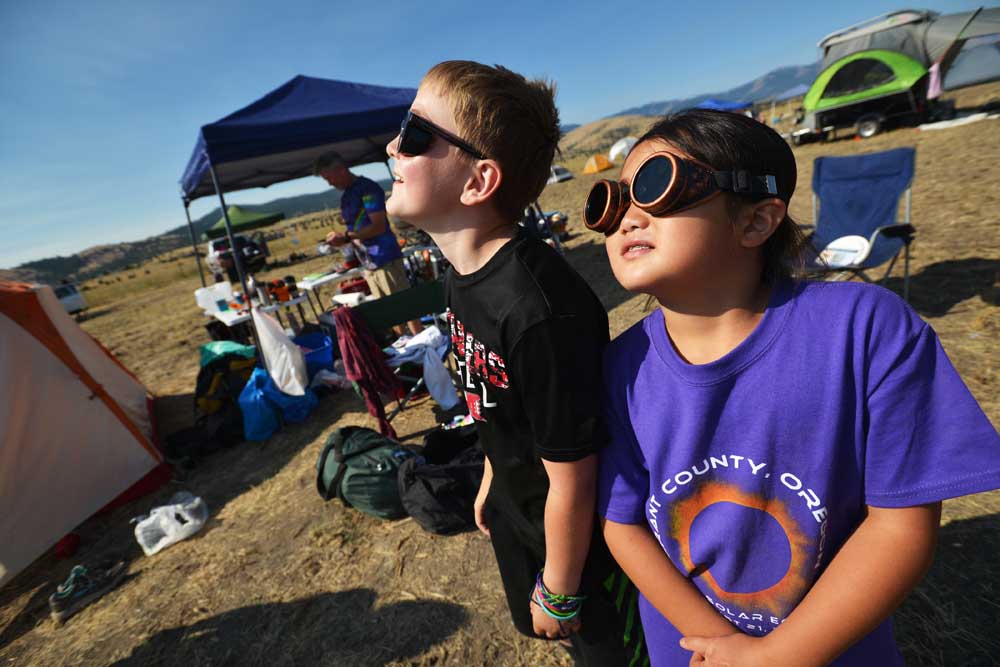Rainbow Gathering, eclipse bring thousands of visitors
Published 11:08 am Tuesday, December 26, 2017

- Henry Greutert and Katie Mertel, both of Mercer Island, watch the eclipse on Monday in John Day.
The population of Grant County more than doubled during the two biggest events of 2017.
Trending
The national Rainbow Gathering and the total solar eclipse brought thousands of visitors from around the world this summer.
While preparations had been underway for the eclipse for more than a year, the unannounced Rainbow Gathering left little time to prepare.
The decision for the annual gathering to take place on the Malheur National Forest between John Day and Seneca was made at a previous meeting in early June in northern Grant County.
Trending
The Rainbow gathering is held annually on public lands, hosted by a loosely organized group that refers to itself as the Rainbow Family. First started as a prayer for world peace in 1972, individuals from around the world gather to pray for peace on July 4.
The first public safety call occurred at the planning meeting in June, where Noah James Anthony Destefano of Stockholm, Sweden, was arrested for stabbing a 23-year-old from California. The victim said she was stabbed while intervening in an altercation between two people who were not Rainbow Family members, and were under the influence of LSD and alcohol.
Once the site was determined, Forest Service personnel attempted to flag off sensitive areas to mitigate damages but said the environmental impact from the unauthorized event would be “detrimental.”
As 13,000 people trickled in over the next several weeks until the July 4 prayer, emergency personnel remained busy responding to medical emergencies, shoplifting and violence. Grant County Sheriff Glenn Palmer said his deputies and others were “running nonstop” with few days off since mid-June.
Palmer said two people died at the event: George Ernest Rogers III, 43, of Dumas, Texas, and William Pasko, 74, of Takoma Park, Maryland. Pasko died of natural causes from a heart attack July 3. Rogers collapsed near a makeshift medical station at the gathering July 2. Stabbings and beatings also occurred at the event, Palmer said.
At least 15 arrests were made on the national forest, and 117 violation notices were issued, according to the Forest Service. Kevin Sonoff, a spokesman for the U.S. Attorney’s Office, said about a quarter of the arrests were felonies. About half of the violations were related to traffic or vehicle offenses, he said, and about a quarter were related to drugs. Other violations were related to alcohol, officer interference, fires and forest roads and trails.
Mobile federal court sessions were held near the site to alleviate the load on the local court system. The Grant County District Attorney’s Office had fewer than 15 cases related to the Rainbow Gathering, primarily for intoxicated driving, disorderly conduct and shoplifting.
After the gathering, a smaller crew stayed to clean up the site for the next several weeks, with the goal of making it look as if the gathering never occurred. Truckloads of garbage were removed from the site.
By early August, the Forest Service spent more than $450,000 responding to the gathering, with ongoing costs expected for rehabilitation and monitoring. Blue Mountain Hospital District increased staffing and expected to be hit with about $100,000 in uncompensated care. Other agencies reported smaller expenses from the gathering as well.
A few weeks after most of the gathering attendees had departed, another group descended on Grant County to see a spectacle in the sky Aug. 21: the total solar eclipse.
The local communities had been planning for the eclipse and procured facilities and supplies for the extra visitors. Science experiments and entertainment, such as a music festival and private concerts, were also lined up.
Dayville science teacher Jim Latshaw and students sent two high-altitude balloons 90,000 feet up to provide a unique view of the eclipse from space. Grant Union teacher Sonna Smith and students participated in a coast-to-coast project taking photos through a telescope. Long Creek hosted lectures. NASA scientists viewed the event from Unity.
All commercial lodging had been booked well in advance, but most cities and schools and many private residents profited from the event by renting out camping sites.
John Day City Manager Nick Green estimated more than 10,000 people stayed in town, including 3,000 who camped at the John Day Industrial Park and the former Oregon Pine mill site. The city made about $75,000 from the event.
Forest Service campgrounds were also full. A major concern was the risk of wildfires. The Forest Service implemented a large fire prevention campaign in advance of the eclipse rush, and no human-caused fires were reported.
The hospital planned for heavy traffic, even bringing in outside volunteers, but the weekend was much calmer than anticipated.
“It was crazy, just how quiet it was,” Public Relations Director Jenna Knowles said. “We were prepared for a lot different scenario.”
Local businesses reported a sizable bump from the eclipse. Gas stations and restaurants reported more than double average sales.
Chester’s Thriftway manager Bill Wyllie said his store was more than prepared for the eclipse and had record sales, “a 13 percent increase in business across the board.”
The Rainbow Gathering acted as a good practice run for the eclipse, Wyllie said, though for the eclipse people were a bit friendlier.
Feedback from eclipse visitors about Grant County was overwhelmingly positive.









